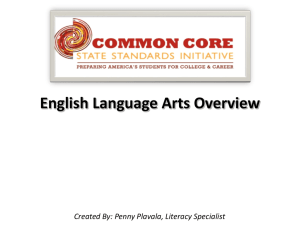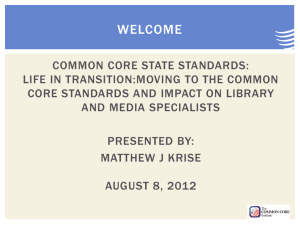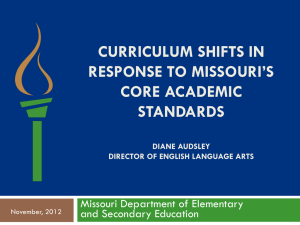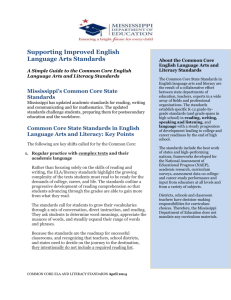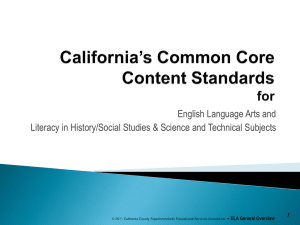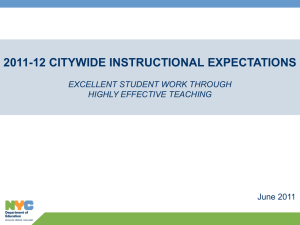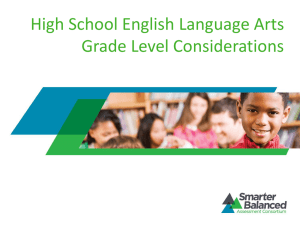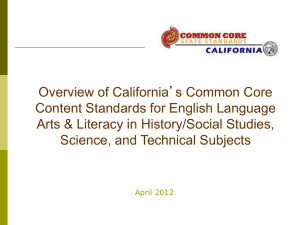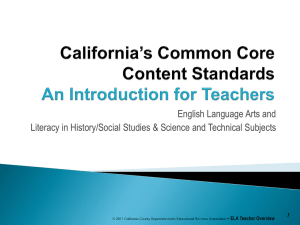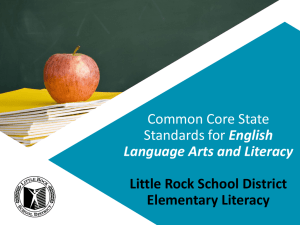3 Standards
advertisement
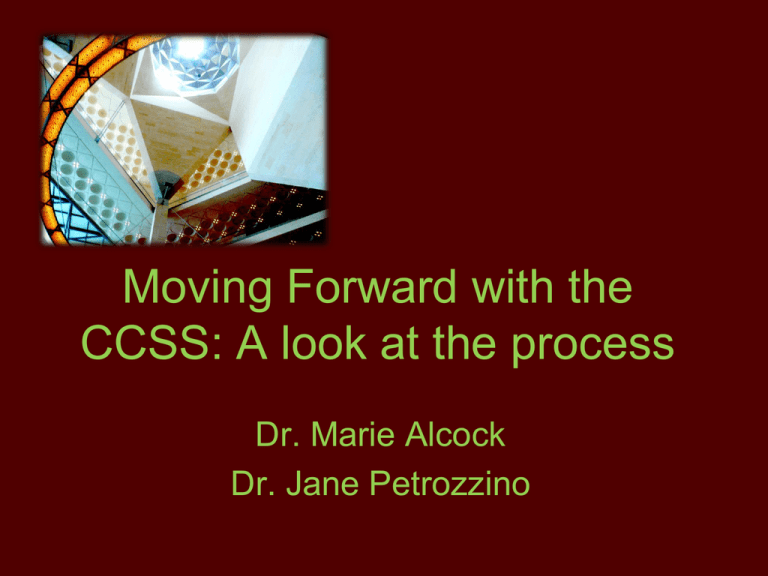
Moving Forward with the CCSS: A look at the process Dr. Marie Alcock Dr. Jane Petrozzino What We Know About Effective Schools A “guaranteed and viable curriculum is the #1 school-level factor impacting student achievement.” -Marzano, What Works in Schools Common Core State Standards http://corestandards.org Focusing on the Instructional Shifts in the CCSS Dr. Marie Alcock Dr. Jane Petrozzino Focused Deep Understanding Coherence Application Fluency Dual Intensity SIX SHIFTS IN MATHEMATICS www.EngageNY.0rg Standards for Mathematical Practices 1. Make sense of problems and persevere in solving them. 2. Reason abstractly and quantitatively. 3. Construct viable arguments and critique the reasoning of others. 4. Model with mathematics. 5. Use appropriate tools strategically. 6. Attend to precision. 7. Look for and make use of structure. 8. Look for and express regularity in repeated reasoning. Mathematics Common Core Grades 1-5 Operations and Algebraic Thinking • • • • Addition, subtraction, multiplication, division Patterns and expressions Numerical expressions Whole numbers Numbers and Operations in Base Ten • • • • Place Value Counting Sequence Properties and Operations Multi-Digit Arithmetic Numbers and Operations – Fractions (Grades 3-5) •Fractions as numbers •Fraction equivalents •Decimal notations •Add and Subtract Fractions Measurement and Data •Measurable attributes •Classification and Categorization •Time •Length units •Represent and interpret data •Geometric measurements Geometry •Shapes and their attributes •Classification •Graphing • • • • • • Standards for Mathematical Content for High School Number and Quantity Algebra Functions Modeling Geometry Statistics & Probability Every Teacher Is A Language Teacher Upgrading language skills across all. curriculum areas Interdependence of the four language skills. EVERY test we give in EVERY subject is language based. Reading Writing Speaking Listening Building Balancing Knowledge in Informational and Literary Text Disciplines Staircase of Complexity Text-Based Answers Writing from Sources Academic Vocabulary SIX SHIFTS IN ELA/LITERACY www.EngageNY.0rg The College and Career Ready Student in ELA CLIs • Independent, collaborative, self-directed • Strong Content Knowledge • Adapt and Adjust Communication • Comprehend and Critique • Value Evidence • Tech & Media Literate • Cultural Understanding ELA Standards • • • • • • Reading for Literature Reading Informational Text Reading: Foundational Skills (K-5) Writing Speaking and Listening Language Literacy in History/Social Studies, Science, and Technical Subjects – Grades 6-12 (integrated in K-5) Reading Strand 10 Standards Writing 10 Standards Speaking & Listening Language 6 Standards 6 Standards Design • CCR and Grade-Specific Standards • Grade levels K-8, Bands 9-10 & 11-12 • Focus on Results rather than Means • Integrated Model of Literacy • Research & Media Skills woven through • One document: Literacy for SS/History and Science/Technology Key Ideas & Details Reading Strand 10 Standards Foundational Skills ( -12) Literature ( -12) Informational Texts ( -12) 3 Standards• Deep Comprehension • Determine Importance & Summarizing Analysis Craft & Structure 3 Standards • Analysis of language and vocabulary • Text Structure • Point of View Integration of Knowledge & Ideas 3 Standards: • Integrate and evaluate content from various sources • Evaluate validity of text claims • Analyzing and comparing texts Range of Reading & Level of Text Complexity • Independently reading increasingly complex text Informational Text • Greater attention to Informational Text • Informational reading in courses other than ELA must take place 8th Grade Literary vs. Informational Observations on Reading • Very High Literacy and Literary Expectations • Highly Rigorous • Independence with complex literacy tasks • Writing Workshop would address all standards • Seminal/foundational U.S. works • • • • • 3 types: arguments/opinion, information/explanatory, narrative Support with reason and evidence Research: short and sustained Technology Appendix B & C (Samples) Text Types & Purposes 3 Standards- Text Types: 1. Argument 2. Informative/Explanatory 3. Narrative Production & Distribution of Writing 3 Standards: 4. Produce Clear and Coherent Writing 5. Quality writing through Writing Process 6. Publish and Produce &Collaborate through Technology Research to Build & Present Knowledge 3 Standards: 7. Short and Sustained Projects 8. Gather and evaluate information from Multiple Sources 9. Text Evidence to support Analysis, Reflection and Research Range of Writing 10. Writing Routinely for both extended and shorter time frames Writing 10 Standards Writing Types Narrative •Personal narrative •Realistic Fiction •Historical Fiction •Memoir •Fiction Informational/ Explanatory •All about… Opinion/ Argument •Personal Essay •How To •Persuasive Research •Literature Response •Argument in SS & Science •Non-Fiction books •Non-Fiction articles •Descriptive text Argument vs. Persuasive • Intent – prove or • Intent – coax the reader disprove the thesis to accept author’s point of view • Logic and facts – Thesis must be disproved or proved with evidence and research • Voice – formal tone • Conclusion – restates thesis and supporting points • Logic and facts – relies on logic and can use suggestion • Voice – can use personal approach • Conclusion – author’s intent and call for future action Observations on Writing • Decreased emphasis on different genres • Starting in 3rd Grade, Standards 1-3 include increased expectations (a-d/e/f) • Writing Workshop would address all standards • Increased emphasis on technology other than word-processing Speaking & Listening • Wide range of settings and formats • Effective Communication • Interpretation & Analysis Observations on Listening and Speaking • Emphasis on diverse media, situations, audiences • Literature Circles, Socratic Seminar • 21st Century Skills: Communication and Collaboration • Technology: audio (2nd grade), multimedia (5th), interactive (9th) Language • Conventions (writing and speaking) • Vocabulary • Integrated into reading, writing, speaking, and listening Observations on Language • Specific grammar skills at each grade • Beyond definitions: Multiple meanings, connotation, figures of speech, word relationships • “General academic vocab AND domainspecific words and phrases” • Mentor texts as models of high quality language R-History/SS 10 Standards R-Science & Tech 10 Standards W-History/SS, Science, &Tech 10 Standards RF RL W WHST RI RH RST SL L The Strands 8th Grade CCR Standard 9: Analyze how two or more texts address similar themes or topics in order to build knowledge or to compare the approaches the authors take. Literature: Analyze how a modern work of fiction draws on themes, patterns of events, or character types from myths, traditional stories, or religious works such as the Bible, including describing how the material is rendered new. Informational Text: Analyze a case in which two or more texts provide conflicting information on the same topic and identify where the texts disagree on matters of fact or interpretation. History/Social Studies: Analyze the relationship between a primary and secondary source on the same topic. Science/Technology: Compare and contrast the information gained from experiments, simulations, video, or multimedia sources with that gained from reading a text on the same topic. Technology • W.K.6: With guidance and support from adults, explore a variety of digital tools to produce and publish writing, including in collaboration with peers. • W.3.6. Keyboarding Skills • W.5.6. Type a minimum of two pages in one sitting Unpacking Standards and Sample units Text Complexity 2005-06 Lexile Framework® for Reading Study Summary of Text Lexile Measures Interquartile Ranges Shown (25% - 75%) Text Lexile Measure (L) 1600 1400 1200 1000 800 600 High School Literature College Literature College High School Textbooks Textbooks * Source of National Test Data: MetaMetrics Military Personal Entry-Level Use Occupations SAT 1, ACT, AP* CCR Reading Standard 1: Read closely to determine what the text says explicitly and to make logical inferences from it; cite specific textual evidence when writing or speaking to support conclusions drawn from the text. K: With prompting and support, ask and answer questions about key details in a text. 3: Ask and answer questions to demonstrate understanding of a text, referring explicitly to the text as the basis for the answers. 7: Cite several pieces of textual evidence to support analysis of what the text says explicitly as well as inferences drawn from the text. 11-12: Cite several pieces of textual evidence to support analysis of what the text says explicitly as well as inferences drawn from the text. Reading • Progressive development of comprehension • Texts of appropriate complexity & increasing sophistication • Appendix A Appendix A • Text Complexity – 3-Part Measurement – Sample Texts – Foundational Skills • Writing Text Types • Speaking & Listening • Language – Vocabulary • Glossary Appendix B • Text Exemplars K-12 – Complexity, Quality, Range • Sample Performance Tasks – Language of standard & standard code • Grade Bands Appendix C • Student samples (K-12) • 3 types of writing*** • Annotation with evidence Readability of Text • • • • • • Importance of Matching Reader to Text Flesh-Kincaid Fry Guided Reading (F&P) ATOS (Grade Equiv.) Lexile Book Wizard…. Appendix B Use your phone, tablet or laptop to participate! Go to m.mentimeter.com Mentimeter answers Levels of materials to have students improve their reading independently… Below level- 15% At level – 85% Challenging level – 0% Foundational Skills • Print Concepts ( 1 only) • Phonological Awareness ( -1 only) • Phonics & Word Recognition ( -5) • Fluency ( -5) Four Generations Advancing into the future •Preparing for next standards from CCSSO •Integrating 21st century skills •Replacing dated content •Upgrading to contemporary assessment types •Map professional development •Rethinking school formats and leadership protocols Global Competencies •EdSteps & Asia Society Digital Literacy Media Literacy Global Literacy upgrading Maps for Learner Engagement Screenplays Teleplays Podcasts Broadcasts Documentaries The SKYPE grandmothers Self publishing Social Networking Protocols Grant proposals text messaging protocols Forecasts Video conferences in world language Second life technology CAD blueprints Media criticism Digital portfolios Recast content for timeliness Breakthroughs Contemporary issues International perspectives Modern forms of expression ..A deliberate need to replace and to shed dated curriculum. Plan for the Future Join our Ning •http://curriculum21.ning.com Curriculum21.com • Clearing House List of web 2.0 tools sorted by content area • Learning Commons Network for teachers (40,000.00 members) HOW – Practical Steps Class of 2024- this year’s preschool Are children and youth processing information differently? Teaching is Changing • Nurturing networks • Modeling how to life-long learn Global Educators Online NINGS Criticalthinking.org 5 social-technological trends • Social Production – Knowledge creation • Social Networks – Defining our identities • Semantic Webs – Organizing, interpretation, connections, evaluation • Media Grids – learning to do and be, gaming • Non-Linear learning – disciplines interconnected Stephen Wilmarth , Chapter 5- Curriculum 21: Essential Education in a Changing World ( edited by HH Jacobs), ASCD, 2010 Image courtesy Sivlia Rsoehthal Tolesano www.langwitches.com Bow Drill CCSSO – Global Competency Matrix • Investigate the World • Recognize Perspectives • Communicate Ideas • Take Action Web 2.0Strategic Interactive Instruction • Interactive • Replacement • Skill reinforcing • ‘De-gimmickifi-cation” Tag Galaxy Wordle Vocab Grabber Gapminder WolframAlpha Contact Information Learning Systems Associates www.LSAlearning.com Admin@lsalearning.com Learning Systems Associates
